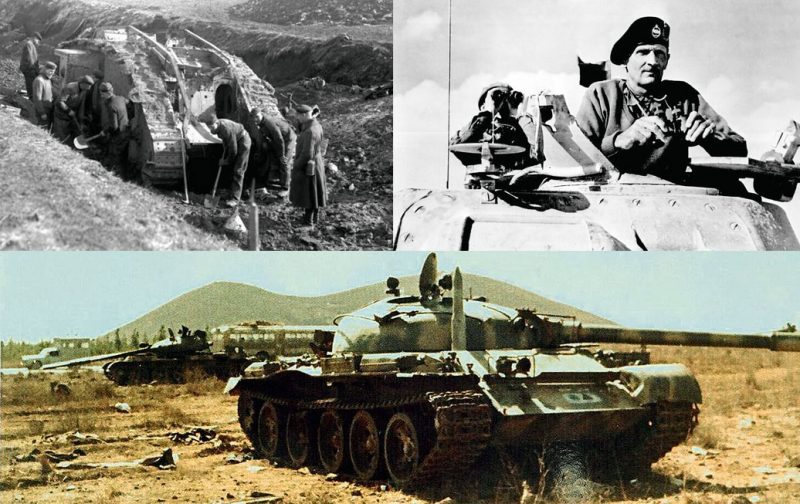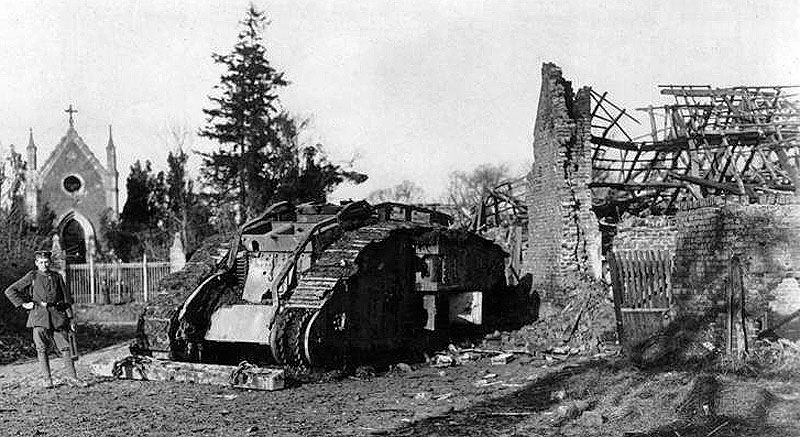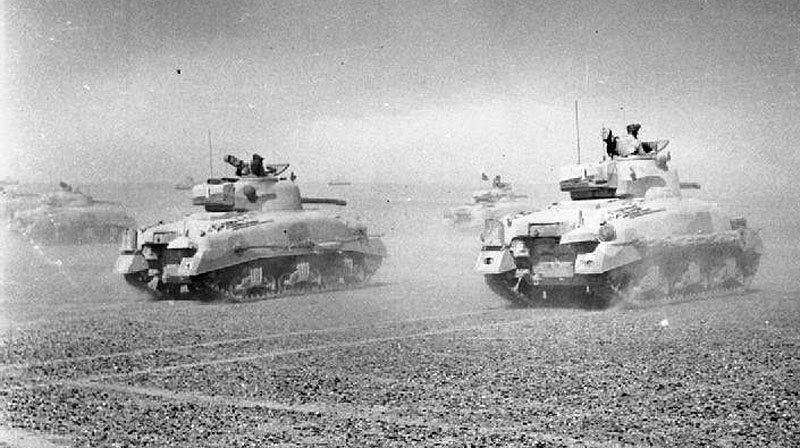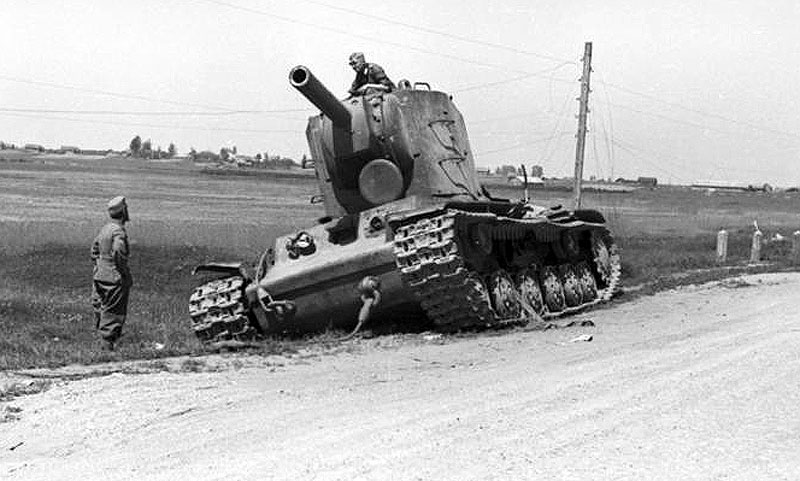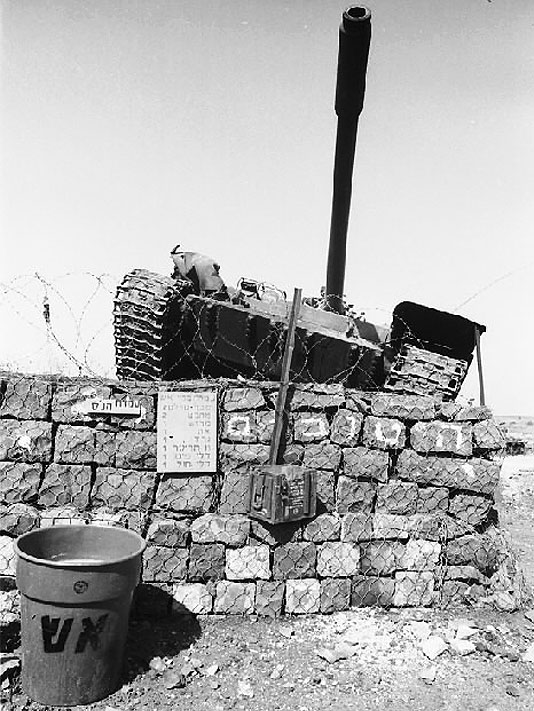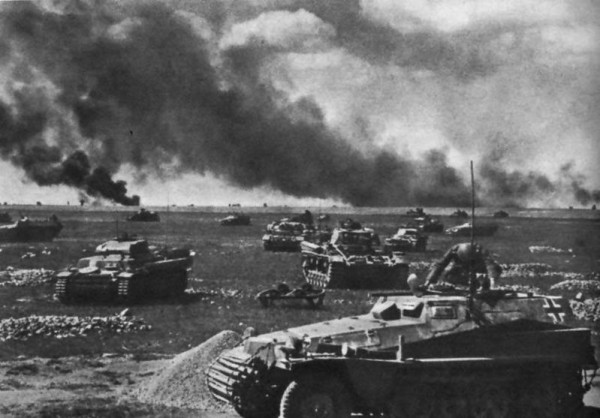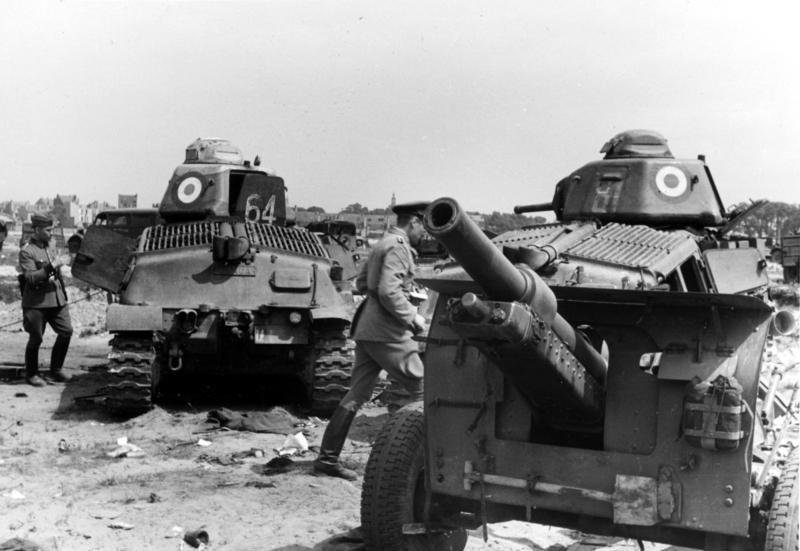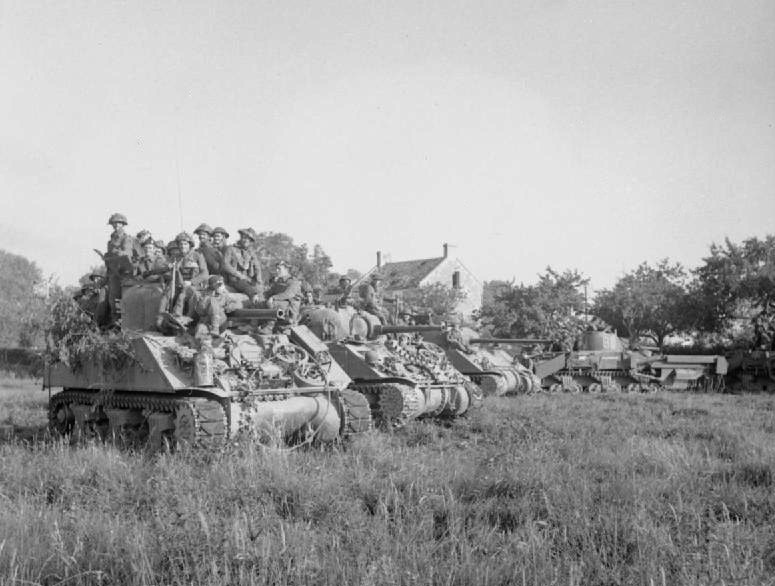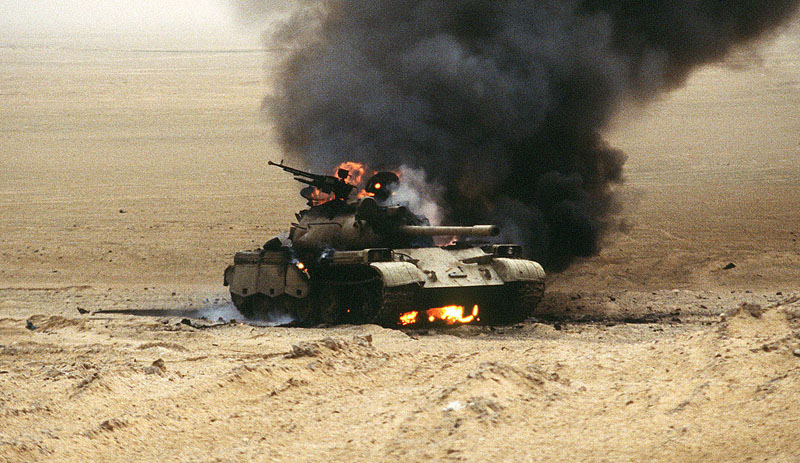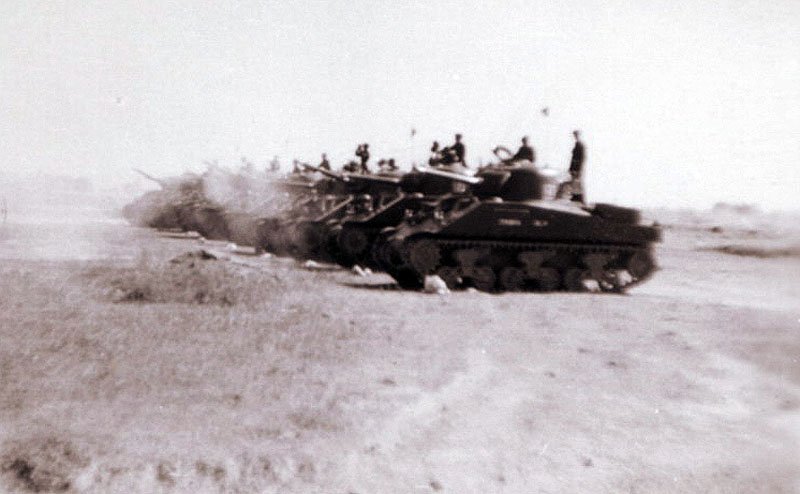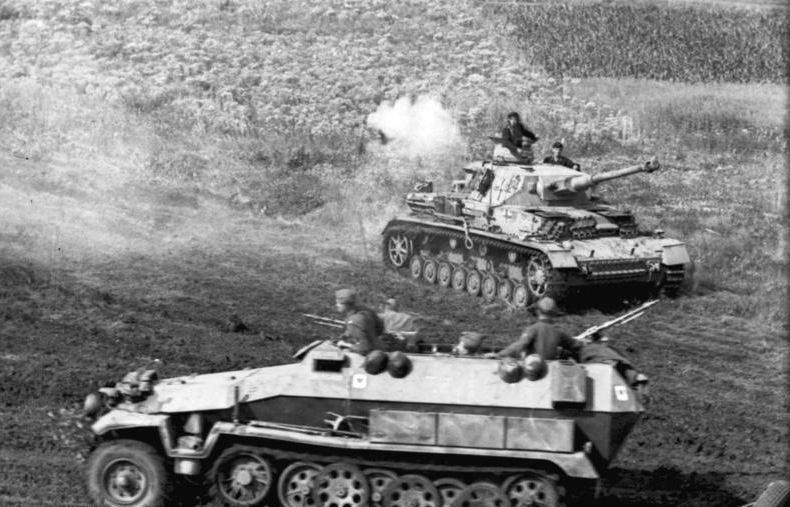Images Used (Clockwise from top left): (1) The Germans captured a British Mark IV tank in November 1917 during the WWI Battle of Cambrai (2) Newly appointed British Eighth Army commander Lieutenant-General Bernard Montgomery watching the advancement of Allied tanks in November 1942 (3) Abandoned Syrian T-62 tanks during Battle of the Valley of Tears in 1973
Tank battle or armored warfare is the use of armored combat vehicles in modern day warfare. The tank is one of the most resilient and devastating army weapons. To break the deadlock of trench warfare in the western front during the WWI, the concept of tank battle was developed. Britain and France simultaneously and separately developed the first tanks during the WWI. The name ‘tank’ was adopted for the British ‘land ships’ in 1915 to conceal the secrecy of the armored vehicles. In an effort to fool the enemy spies, British army propagated that they had been building ‘mobile water tanks’.
The world saw tanks in battle for the first time on September 15, 1916, when British Army deployed these armored land ships during the Battle of the Somme. Throughout 20th century, tanks have played a dynamic role for the army and it has seen fierce and devastating action. It is a strong mobile weapon platform with a large caliber rotating cannon capable of preventing enemy vehicles from advancing. It has also got heavy vehicle armor giving tanks to perform superbly during a tactical situation. From the late WWII havoc during the Battle of the Bulge, in which over 2638 tanks and 902 armored fighting vehicles took part, to the 1981 Battle of Dezful during the 8 year long Iran-Iraq war, tanks performed as most significant offensive weapons around the world. Top 10 epic tank battle sagas in military history are scrutinized here.
(10) Battle of Cambrai (November 20, 1917 to December 7, 1917), 476 tanks took part:
WWI Battle of Cambrai in France in the Western Front was a British offensive and a German counter-offensive warfare. It was the first effective deployment of large number of tanks in any battle ever. However, it was not the first time tanks were deployed. World saw deployment of tanks for the first time in September 1916. Tanks were also deployed in large numbers by Britain during the third Battle of Ypres and by France in early 1917. But those deployments were less effective than in Cambrai where the British forces deployed 476 tanks.
The British plan was to infiltrate the German Hindenburg Line. This defense line was considered impenetrable previously. The British forces enjoyed successes on the first day of the battle. However, on the second day, mechanical shortcomings and frailties of the British Mark IV tanks against German infantry defenses and artillery were exposed. 2 British Corps (A military formation that might typically consist of 20,000 to 40,000 soldiers) and 1 German Corps took part in the battle. Gains and losses for the opposing forces were proportionate by the end of the battle and the result of the battle was virtually a stalemate situation. The British had 44,000 casualties and the figure for the Germans was 45,000. 179 British tanks were destroyed which resulted in improvements of British tank designs in 1918.
Image Used: The Germans captured a British Mark IV tank in November 1917
(9) Second Battle of El Alamein during WWII (October 23, 1942 to November 11, 1942), 1576 tanks took part:
Tanks played a huge role in the Second Battle of El Alamein that took place near the Egyptian coastal city of El Alamein in 1942. The Allied forces deployed 195,000 combatants, 1029 tanks, 435 armored vehicles, 730 to 750 aircraft, 892 to 908 artillery units and 1,451 anti-tank guns. Axis forces deployed 116,000 men, 547 tanks, 192 armored vehicles, 770 to 900 aircraft, 552 artillery units and 496 anti-tank guns. The Axis forces wanted to gain access to the Persian and Middle Eastern oil fields by controlling North Africa.
The Allied forces had total numerical superiority over the Axis forces during this battle in the Western Desert. The Allies also could overcome their quality factor of their equipment with the arrival of Spitfire, 6-pounder anti tank guns and Sherman tanks. The Axis forces lost 30,542 combatants, around 500 tanks, 254 guns and 84 aircraft. The Allies lost 13,560 combatants, 332 to 500 tanks, 111 guns and 97 aircraft. In this battle, the Allied forces achieved the first absolute victory against the Axis forces and the Germans lost possession of Suez Canal and Egypt. Winston Churchill said that there hadn’t been any allied victory before Alamein and there hadn’t been a defeat after it.
Image Used: American Sherman tanks moving at speed across the northern Egyptian desert as the Axis forces retreating on November 1, 1942 during the Second Battle of El Alamein
(8) Battle of Raseiniai during WWII (June 23, 1941 to June 27, 1941), 994 tanks took part:
The Battle of Raseiniai in Lithuania was tank battle fought between Soviet Union and Germany in the Eastern Front during WWII. The Soviet elements of the 12th Mechanized Corps and 3rd Mechanized Corps fought with 749 tanks against the German elements of the 4th Panzer Group which had 245 tanks.
The Russian tanks were technically superior to their German counterparts. The Russians had over 50 Kliment Voroshilov KV-1 and KV-2 tanks which kept advancing. But the Germans systematically overpowered the Soviet tanks. The Russian aircraft could not do much damage to the German Luftwaffe (air force) aircraft and German Air fleet severely destroyed Soviet tanks and vehicles. The Germans suffered little damages while Soviet Union lost 704 tanks in the battle.
Image Used: A single KV-2 heavy tank managed to cut off the German 6th Panzer Division for one day during the Battle of Raseiniai
(7) Battle of the Valley of Tears during the Yom Kippur War (October 6, 1973 to October 9, 1973), around 1436 tanks took part:
Israel and the Arab coalition forces led by Egypt and Syria fought in the Yom Kippur War in October 1973. Battle of the Valley of Tears was part of this conflict between Israel and Syria at the Syrian Golan Heights. Tanks were the major war elements in the surprise attack that took place at the Valley of Tears on the holiest day in Judaism called ‘Yum Kippur’.
Syria deployed 1 infantry division with around 500 tanks and vehicles while the Israel engaged 1 armored brigade with around 100 tanks. The Syrian forces were backed up by 900 more tanks and the total Syrian tank participation in the battle is estimated to be 1260. 400 of the Syrian tanks were T-62s, the most modern Soviet tanks during that time. The Syrian forces started the offensive and 100 aircraft also took part in a Syrian airstrike. Israeli forces initially managed to deploy only 176 tanks. Though the Syrians gained much ground during the first offensive of the battle, they failed to move their tanks across the Israeli anti-tank ditches. The Syrian war planners expected an Israeli reinforcement after at least 1 day. However, Israeli forces received reinforcement within just 15 hours after the battle started. Israeli Air Force also took part in action. The Syrian forces withdrew on the Fourth day. The Israeli forces lost 60-80 tanks while the Syrian forces lost total over 500 vehicles including 260 to 300 tanks. Poor defensive tactics of the Syrian forces, IAF (Israeli Air Force) superiority and also an Israeli threat of a nuclear strike on Syria were pointed out by different analysts to be the causes of the Syrian defeat.
Image Used: A destroyed Syrian T-55 tank at Nafakh on the Golan Heights during the Battle of the Valley of Tears in October 1973
(6) Battle of Brody during WWII (June 23, 1941 to June 30, 1941), 4250 tanks took part:
Until the Battle of Kursk in 1943, the Battle of Brody in Western Ukraine had been called ‘The largest tank warfare of WWII’. Germans had 750 tanks lined up against 3,500 Soviet tanks. An army corps and a motorized army corps were deployed by the Germans. On the other hand, five ‘mechanized corps’ were deployed by Soviet Union during this warfare.
Though Red Army inflicted significant damages on the German forces, the German forces outmaneuvered the Soviets and caused 4 times more tank damages. German Air Supremacy, poor Soviet military logistics and lack of proper chain of command resulted in a victory for German armed forces. German forces lost around 200 tanks while the Red Army lost around 800 tanks, 201 of which were destroyed by German Luftwaffe airstrikes. Numerical superiority of the Soviet T-34 tanks could not overcome the German firepower and Axis forces pressed forward. It was one of the most intense tank battles during the first phase of ‘Operation Barbarossa’, code name for Hitler’s invasion of Soviet Union.
Image Used: German forces advancing during the Battle of Brody in June 1941
https://www.youtube.com/watch?v=0oYwe9xWuss
Video Used: A US newsreel film about the Red Army’s resistance against Nazi forces in 1941.
(5) Battle of Hannut during WWII (May 12, 1940 to May 14, 1940), 1274 tanks and armored vehicles took part:
The Allied forces of France, Belgium and Netherlands fought against the Nazi German forces at Hannut, Belgium in May, 1940. The Germans tried to thrust through Ardennes region in an effort to overpower the strongest elements of the 1st French Army there.
20,800 combatants and 600 Tanks and Armored Fighting Vehicles were deployed by the Allied forces. 25,927 personnel, 618 tanks, 108 artillery pieces and 1,252 aircraft were deployed by the Nazi German forces. Though the battle was almost a stalemate, the French forces achieved some tactical successes. 121 of the Allied tanks were destroyed or damaged. 29 of the German tanks were destroyed and 111 more were damaged in the battle. German forces could not achieve their target of neutralizing the threat of the French First Army.
Image Used: Two destroyed French tanks, SOMUA S35s are being inspected by the Nazi German soldiers.
(4) Operation Goodwood during WWII (July 18, 1944 to July 20, 1944), 1477 tanks took part:
Operation Goodwood in Normandy, France was a British offensive against the German forces in July 1944. It is called by some historians as ‘the largest tank battle in British Army’s history’. British forces deployed 2 infantry divisions and 3 armored divisions with 1,100 tanks. The Germans engaged 4 infantry divisions, 3 armored divisions, 2 heavy tank battalions with 377 tanks. The British forces wanted to take control of Caen in Northwestern France to liberate the rest of the occupied country.
The British forces advanced 7 miles to the eastern part of the city and the Germans prevented a total breakthrough. The British had 3,474 casualties and lost 314 tanks. The Germans had unknown number of casualties but over 2,500 German soldiers were captured and they had lost 75 to 100 tanks in the battle.
Image Used: British infantry carried by M4 Sherman and one modified British version of Sherman, Sherman Firefly tanks during Operation Goodwood on July 18, 1944
(3) ‘Battle of 73 Easting’ during the Gulf War (February 26, 1991 to February 27, 1991):
‘Battle of 73 Easting’ was tank battle fought between Saddam Hussain’s Iraqi forces and Coalition forces led by American and British armored forces at southeastern Iraq in February 1991. It was part of the Gulf War that began after Saddam Hussain’s Iraqi forces invaded and annexed Kuwait.
The US armored forces attacked and severely destroyed the Iraqi forces. The coalition forces lost 1 combatant with 12 more wounded and lost a Bradley Infantry Fighting Vehicle. 57 more coalition soldiers were wounded due to friendly fire (an unintended attack by allied forces while attempting to attack the enemy). Iraqi forces had 600 to 1000 casualties and lost 85 tanks, 30 wheeled vehicles, 40 AFVs and more than 2 artillery batteries.
Image Used: A destroyed Type 69 Chinese tank used by Iraqi forces during the Battle of 73 Easting on February 28, 1991
(2) Battle of Chawinda during the Indo-Pakistani War (September 14, 1965 and September 18, 1965 to September 19, 1965), over 375 tanks took part:
Battle of Chawinda in Pakistan during the 1965 Indo-Pakistani War was the largest tank war since the Battle of Kursk in WWII. The 1965 Indo-Pakistani War is also known as the Second Kashmir War and was fought between the two South Asian nations over the disputed region of Kashmir. Both sides were evenly matched. Pakistani forces had 80,000 infantry, significant number of cavalry units, over 150 tanks and further reinforcement of tanks. India had 80,000 to 150,000 infantry, significant number of cavalry units and total 225 tanks.
Indian army planned to seize the Grand Trunk Road around Wazirabad in Punjab, Pakistan and the Sialkot-Pasrur railway in an effort to cut off the Pakistani forces fighting in the Kashmir Border region. The Pakistani forces received quick reinforcements from Kashmir and situation improved for them. Tank battle took place near Phillora (near Sialkot) in Punjab, Pakistan. The fighting intensified and the Pakistani forces at Phillora retreated. The advancing Indian forces were stopped at Chawinda. United Nations interfered to end hostilities on September 22, 1965. Pakistan lost 44 tanks and India lost 120 tanks. However, India claims that they lost 29 tanks in the battle.
After the UN mediated unconditional ceasefire, India held about 200 square miles or 518 square kilometers of Pakistani Territory in Sialkot sector and Pakistan held up to 1,600 square miles of Indian Territory (of which 1,300 square miles were desert sectors). An Australian news media ‘The Australian’ mentioned Pakistan as the victorious side in this battle.
Image Used: Tanks of Indian Army on the move during the 1965 Indo-Pakistani War
(1) Battle of Prokhorovka during the WWII Battle of Kursk (July 12, 1943), around 1140 tanks took part:
Battle of Prokhorovka was fought between Soviet Union and Germany at Prokhorovka which is 87 km southeast of Kursk, Russia on the Eastern Front. It was one of the largest tank battles in history. Germany deployed 3 Panzer divisions with around 290 tanks while the Soviets deployed 15 military corps with around 850 tanks.
After intense fighting, the outcome of the battle was not conclusive. It was considered to be tactical victory for the Germans but not an operational victory. The Germans had 842 casualties and lost 43 Armored Fighting Vehicles and tanks. The Soviets had 7,607 casualties and lost 500 to 550 Armored Fighting Vehicles and tanks. Soviets claimed a propaganda victory as after this battle Hitler called off the Eastern offensive on the Kursk salient to concentrate attacks on the Western Front. The Soviets prevailed despite heavy losses in this period of WWII and the tide was beginning to turn away from the Nazi German forces.
Image Used: German Panzer IV tank and Sdkfz 251 halftrack on the move during the Battle of Prokhorovka in July 1943
